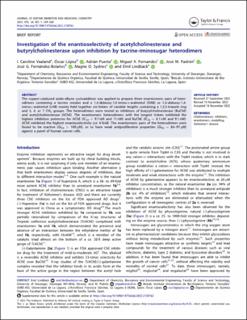Investigation of the enantioselectivity of acetylcholinesterase and butyrylcholinesterase upon inhibition by tacrine-iminosugar heterodimers
Vaaland, Ingrid Caroline; Lopez, Oscar; Puerta, Adrian; Fernandes, Miguel X.; Padron, Jose M.; Fernandez-Bolanos, Jose G.; Sydnes, Magne Olav; Lindback, Emil
Peer reviewed, Journal article
Published version
Permanent lenke
https://hdl.handle.net/11250/3097151Utgivelsesdato
2023-09Metadata
Vis full innførselSamlinger
Originalversjon
Vaaland, I.C., Lopéz, O., Puerta, A., Fernandes, M.X., Padrón, J.M., Fernandez-Bolanos, J.G., Sydnes, M.O. & Lindback, E. (2023) Investigation of the enantioselectivity of acetylcholinesterase and butyrylcholinesterase upon inhibition by tacrine-iminosugar heterodimers. Journal of Enzyme Inhibition and Medicinal Chemistry, 38 (1), 349-360. 10.1080/14756366.2022.2150762Sammendrag
The copper-catalysed azide-alkyne cycloaddition was applied to prepare three enantiomeric pairs of heterodimers containing a tacrine residue and a 1,4-dideoxy-1,4-imino-D-arabinitol (DAB) or 1,4-dideoxy-1,4-imino-L-arabinitol (LAB) moiety held together via linkers of variable lengths containing a 1,2,3-triazole ring and 3, 4, or 7 CH2 groups. The heterodimers were tested as inhibitors of butyrylcholinesterase (BuChE) and acetylcholinesterase (AChE). The enantiomeric heterodimers with the longest linkers exhibited the highest inhibition potencies for AChE (IC50 = 9.7 nM and 11 nM) and BuChE (IC50 = 8.1 nM and 9.1 nM). AChE exhibited the highest enantioselectivity (ca. 4-fold). The enantiomeric pairs of the heterodimers were found to be inactive (GI50 > 100 µM), or to have weak antiproliferative properties (GI50 = 84–97 µM) against a panel of human cancer cells.

